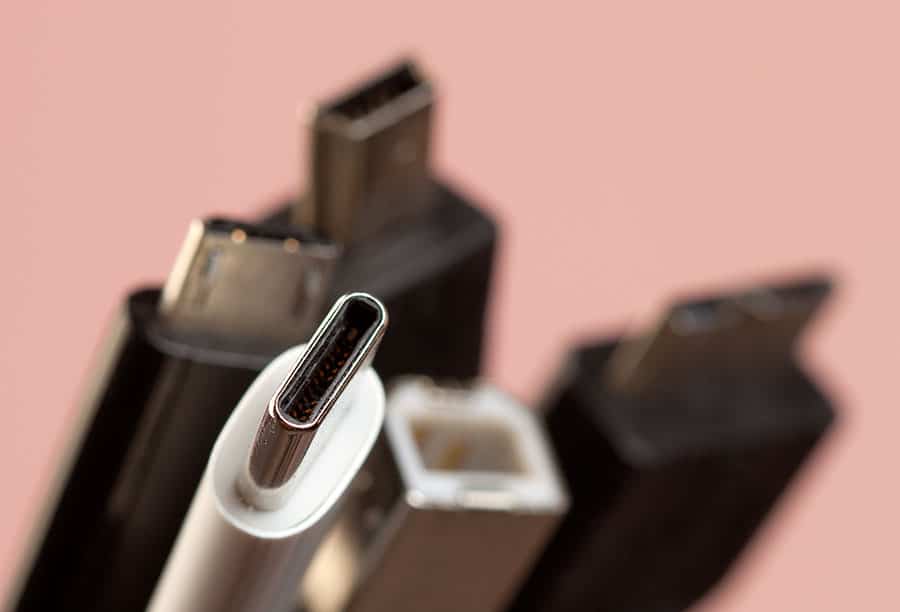
Above: Generations of USB plugs, USB-C is at front centre. Photo by Mark Lyndersay.
BitDepth#1197 for May 16, 2019
With the introduction of the USB-C connector, it seems that the folks behind the widely used connection protocol finally got it right. And it took only 24 years.
The original Universal Serial Bus connector began development in 1994 and was released in 1996. The most popular version of USB-1 transferred 12 MBits, barely adequate to transfer data from a hard drive.
The connector found a home on the first iMac, which inspired the computer industry to ditch the bulky serial connectors that were the norm on devices until then. Slower devices, such as keyboards, connected at 1.5 Mbits.
USB-2 took a big jump to 480 MBits, making it suitable for a wide range of computing applications and it’s here that things began to go a bit awry.
USB cables arrived with just two connectors, the familiar USB-A port, a wide, flat plug and receptacle and the USB-B port, a smaller square plug and port intended for devices.
Many USB scanners and printers still use a version of the USB-B port.
Even smaller devices needed to connect to USB, including phones once power delivery was introduced to the protocol in August 2007, so a dizzying number of thinner connectors were soon introduced.
Depending on the device you used, you were required to have a plug with either a Mini-A, Mini-B, Mini-AB, Micro-A, Micro-AB, or Micro-B connector.
Meanwhile, the USB protocol took another jump to USB-3 in 2008 with a new 5 GBit protocol. That doubled every five years until 2017. This year a provisional USB-4 protocol was announced.
USB-3 still uses a connector that looks like the original USB-1 computer connector for backwards compatibility, but a “SuperSpeed” version of that cable supporting faster data transfer is available for professional use.
More common now is the oval-shaped USB-C connector, which has become the default on new smartphone devices.
The new USB-C plug solves the most infuriating question that’s haunted USB since its introduction – which side is the right-side up. The new connector can be plugged in either way, but that hasn’t solved the challenges of popularity.
USB now ferries a wide range of data and power specifications and it seems as if every USB-3 and USB-C plug and outlet is configured differently. Add Thunderbolt 3 to the mix.
The latest version of the high-speed data protocol championed by Apple also rides on a USB-C connector, jumping from the previous version’s use of a connector based on the DisplayPort video plug.
The new USB-C plug solves the most infuriating question that’s haunted USB since its introduction – which side is the right-side up.
Thunderbolt 3 carries dozens of watts of power, control signals, data transfer up to 40 GBit and 4K video signals.
Is there a single cable that supports every protocol? A golden master connector that will ferry everything that a USB-C connector can deliver, including power, data and control signals to all the devices it can connect to?
Not that I can find. Cables are designed to connect a particular flavour of USB-C to a particular range of supported devices, though a Thunderbolt 3 cable, unsurprisingly the most expensive of the lot, comes close.
This is particularly important for computer users, particularly on mobile devices, who will usually need a dock or port multiplier to expand connectivity options as more portables simplify connections to one or two USB-C ports.
Cheap isn’t a good idea when it comes to buying USB-C cables and devices either. Low-cost cables may skip entire protocols or implement them poorly, which introduces the potential to destroy expensive gear with a cheap connector.
Your USB-C device can probably do more than you expect with the right connector, just be careful what you plug into it.



